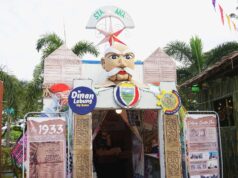CLARK FREEPORT – The state-owned Clark Deve-lopment Corp. (CDC) is negotiating with the Philippine Export Processing Authority (PEZA) for its plan to manage some 10,674 hectares of untapped lands north of this 4,500-hectare freeport, as it bared last week a master plan to develop the area at P11.18 billion.
CDC president and chief executive officer Benigno Ricafort presented to media the master plan which will tap initially only 2,477 hectares of flat lands in the mostly hilly area which used to be known as Sacobia largely within the boundaries of Tarlac province.
The huge area is linked to this freeport by a bridge constructed as part of the mothballed Expo Pilipino theme park in this freeport.
The land used to be under the Bases Conversion Development Authority (BCDA) with CDC as implementing arm but was placed under the authority of the PEZA after Clark’s main economic zone was converted last year into a freeport covering the 4,500 hectares.
The CDC now refers to the vast property as “next frontier”, amid a growing demand from foreign and local investors for space in the almost fully leased out lands within the freeport.
This, even as Ricafort announced that Congress has already lifted its objections to the memorandum of agreement (MOU) the CDC entered into with Aeta tribal folk whose ancestral lands are within the new frontier. The agreement gave the CDC the right to manage the tribal lands, in return for some 20 percent share of profits from investors there for the Aeta communities.
“Congress has already given the go signal for us to push through with the MOU,” he announced.
The master plan for the new frontier noted that of the total 2,477 hectares of flat lands, 1,582 hectares are “leasable”. It also said such an area could accommodate 334 hectares for investors, 242 hectares for “service centers”, 154 hectares for informal settlers and farms, and 165 hectares for roads. Hundreds more of hectares have been allocated for a Taiwan economic zone.
“Our new product lines for the new frontier are eco-tourism, agro-industry, housing, and community development,” Ricafort said.
Already, the CDC has been negotiating for the establishment of a Taiwan economic zone in the area. This has already been included in the master plan which allocates two sites for the Taiwanese Donggwang investor, one covering 265.26 hectares and another covering 250.52 hectares.
The master plan also covered two separate sites with a combined area of 51 hectares for Orchids World, 25.75 hectares for Green Canyon tourism project, a 10-hectare wake boarding area proposed by the Philippine Tourism Authority, a 361-hectare industrial zone, and 25 hectares for a branch of the Philippine Science High School.
The master plan also proposes to cluster existing Aeta villages within the next frontier.
CDC president and chief executive officer Benigno Ricafort presented to media the master plan which will tap initially only 2,477 hectares of flat lands in the mostly hilly area which used to be known as Sacobia largely within the boundaries of Tarlac province.
The huge area is linked to this freeport by a bridge constructed as part of the mothballed Expo Pilipino theme park in this freeport.
The land used to be under the Bases Conversion Development Authority (BCDA) with CDC as implementing arm but was placed under the authority of the PEZA after Clark’s main economic zone was converted last year into a freeport covering the 4,500 hectares.
The CDC now refers to the vast property as “next frontier”, amid a growing demand from foreign and local investors for space in the almost fully leased out lands within the freeport.
This, even as Ricafort announced that Congress has already lifted its objections to the memorandum of agreement (MOU) the CDC entered into with Aeta tribal folk whose ancestral lands are within the new frontier. The agreement gave the CDC the right to manage the tribal lands, in return for some 20 percent share of profits from investors there for the Aeta communities.
“Congress has already given the go signal for us to push through with the MOU,” he announced.
The master plan for the new frontier noted that of the total 2,477 hectares of flat lands, 1,582 hectares are “leasable”. It also said such an area could accommodate 334 hectares for investors, 242 hectares for “service centers”, 154 hectares for informal settlers and farms, and 165 hectares for roads. Hundreds more of hectares have been allocated for a Taiwan economic zone.
“Our new product lines for the new frontier are eco-tourism, agro-industry, housing, and community development,” Ricafort said.
Already, the CDC has been negotiating for the establishment of a Taiwan economic zone in the area. This has already been included in the master plan which allocates two sites for the Taiwanese Donggwang investor, one covering 265.26 hectares and another covering 250.52 hectares.
The master plan also covered two separate sites with a combined area of 51 hectares for Orchids World, 25.75 hectares for Green Canyon tourism project, a 10-hectare wake boarding area proposed by the Philippine Tourism Authority, a 361-hectare industrial zone, and 25 hectares for a branch of the Philippine Science High School.
The master plan also proposes to cluster existing Aeta villages within the next frontier.




